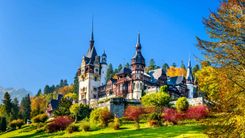During one afternoon of exploring, our group wandered to the most well-known symbol of the city - the iconic, abandoned Art Nouveau Casino which is currently under restoration and slated to open to the public in autumn 2024.
Located between the commercial and tourist ports, you can immediately see both ancient and modern influences, somewhat of an architectural tapestry of East and West. Up until World War II, the Casino’s ballrooms and reading halls were filled with well-to-do tourists and gamblers making and losing their fortunes, before it was transformed into a hospital to treat soldiers. When World War II ended, Romania emerged under Soviet occupation; several renovation projects have started and failed since then, the latest beginning in 2020.
Far from completion, the landmark still gives off a nostalgic feel, full of stories and secrets - much like the rest of Romania. Each day I spent in Constanța, I definitely learned something new, from old folk traditions to the important messaging modern artists are working hard to share.
Sitting on a bench with a view of the Casino, I took a minute to properly enjoy the view of the Black Sea (and a breather - the sun can be blisteringly hot in summer, though the sea breeze does much to help you out). There’s definitely a romantic feel to the promenade, and the city, that makes you feel connected to Romania’s variegated past. I’m even more curious about its compelling future. With new artists, restaurants and festivals springing up all the time, it’s bound to be an interesting one.
In all, Constanța is a pretty unique place. Here you can explore Roman ruins, check out ornate museums, and then dive into some fantastic street art and music festivals —all with the Black Sea as its backdrop.











